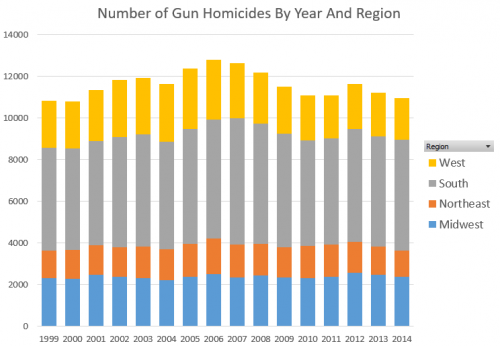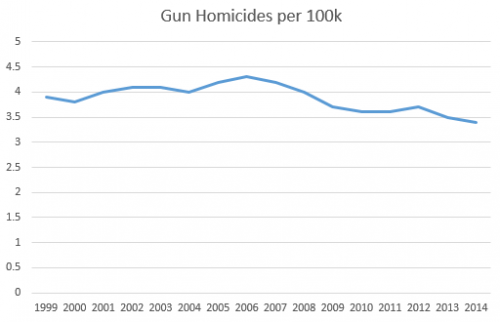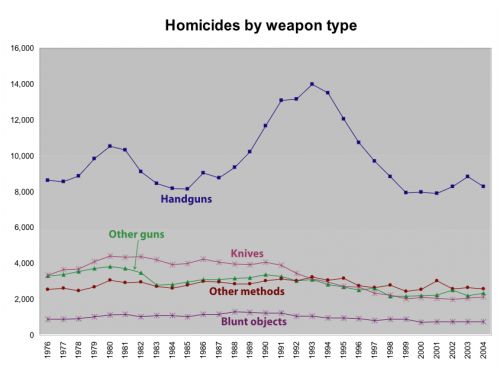There’s a lot of gun violence in the news. I’m not going to get into the politics of it, but it did make me take a look at how bad things really are. Here’s the hypothesis that we’ll test: Gun violence is worse than it’s ever been before.
First, a couple caveats. As a data scientist, I know first hand that data can be beaten into submission to “prove” any hypothesis you want. It takes extra work to really let the data speak for itself and possibly disprove your hunches. And on a related note, it’s difficult to find good data sources. Articles are not reliable because they’re generally very doctored to get their intended point across. The bigger, more reliable studies that publish raw data don’t publish data every year.
The most reliable numbers I could find were from the CDC’s National Vital Statistics Reports published in February 2016. Unfortunately the data in that report is from 2013, but it’s the most recent and trustworthy that I could find. That report states that in 2013, 11,208 of those were firearm homicides. That comes out to 3.5 people out of 100,000 or 0.0035% of the population. Other causes of death in the same range are aortic aneurysms, emphysema, multiple myeloma, stomach cancer and intestinal infections. Homicides by firearms accounted for 0.4% of the all deaths in 2013. By the way, do you want to know what the top three causes of death were?
- Heart disease: 23.5%
- Cancer: 22.5%
- Chronic lower respiratory diseases: 5.7%
My go-to comparison is always vehicle deaths. You’re 3.15 times more likely to die in a car accident than by a gun homicide. Do you worry 3.15 times more about the car accident than the gun homicide?
Those are all numbers from a single year. The original hypothesis was that we’re worse off than we were before so let’s look at some trend data. I spent a bunch of time doing searces in the http://wonder.cdc.gov system. It has data for 1999-2104. Here’s the summary I built for that data:

I had no idea that 45% of gun homicides were in the south! But back to the main point: those numbers don’t show much change. But hold on. They are slightly misleading because they are raw counts. The population grew significantly over that time range. We should be looking at the number of deaths per 100,000 people. That average has decreased:

We’re not finding much data to support our hypothesis, but what about pre-1999? I couldn’t find data in that CDC system pre-1999, but I did find this chart showing that we had a peak in the 90s that was much worse than today. This data comes from the Bureau of Justice Statistics via Wikipedia. Note that these numbers are a bit lower than the CDC numbers for the overlapping years. The CDC has their gun homicide deaths broken down into a number of categories (rifles, shotguns, pistols, terrorism, etc) and I’m guessing the Bureau of Justice Statistics has a slightly different categorization. However, I think it’s still valuable to look at the data:

I lived through that huge spike of gun homicides and had no idea that it existed.
I learned that you have to be really careful when comparing numbers because “gun deaths” can mean a lot of things. Some sites will include suicide by guns in their numbers. Suicide with guns are roughly twice as common as homicides with guns so they really change the numbers. Other articles will do their ratios and percentages based on people under 25. A large majority of the gun violence happens to and by people under 25. Some sites even include war related deaths in their gun numbers. And as you saw above, even reporting the raw totals can be used to trick people if you’re intentionally leaving out the fact that the population changed over that time range.
Do we have a problem? Yep. Would it be a horrifying event to witness? Yep. Should we analyze the data and run experiments to see how we could improve the problem? Yep. Is it worse than used to be? Nope.
P.S. Will any of this data stop people from yelling at other on TV? Nope.
 As I bought my truck, I was left wondering why we still have dealerships. When I got ready to talk to the dealers, I already knew excatly how much my truck would cost them. I had the order form that showed invoice pricing and I knew how much profit they still made on that invoice price. Everything is available online these days. I was even able to track my own truck through the order process. I could see when it started to get built and when it was being shipped. With a couple more phone calls, I could have even figured out exactly which rail car it was on and tracked it’s movements across the country. There are no secrets anymore.
As I bought my truck, I was left wondering why we still have dealerships. When I got ready to talk to the dealers, I already knew excatly how much my truck would cost them. I had the order form that showed invoice pricing and I knew how much profit they still made on that invoice price. Everything is available online these days. I was even able to track my own truck through the order process. I could see when it started to get built and when it was being shipped. With a couple more phone calls, I could have even figured out exactly which rail car it was on and tracked it’s movements across the country. There are no secrets anymore.







 This past weekend was the annual
This past weekend was the annual  I’ve been happily watching my house value skyrocket since we bought it. In less than 5 years, Zillow says we’re up 44%! I say “happily” because it’s nice to see that I bought in a trough instead of at a peak like last time, but since I have no plans to move for quite a while, all it really does is raise my property taxes.
I’ve been happily watching my house value skyrocket since we bought it. In less than 5 years, Zillow says we’re up 44%! I say “happily” because it’s nice to see that I bought in a trough instead of at a peak like last time, but since I have no plans to move for quite a while, all it really does is raise my property taxes.


Payload
How much weight can that truck haul? How much can it tow? I had very little idea how to really answer those questions before I started researching my truck purchase. I figured there was a web page somewhere that you could look it up and figure it out. And that’s sort of correct, but that web page is huge and complicated. Plus it varies by vehicle depending on the options that you chose. So how do you figure it out?
All of the info you need is printed on the inside door frame of the driver’s door. The first sticker of interest is white with black lettering. The key numbers are:
The second sticker is white with yellow, red and black. The main information there is the correct tire pressures but it also tells you “The combined weight of occupants and cargo should never exceed X.”
The one important number that I can’t find anywhere on the stickers is GCWR (gross combination weight rating.) This the maximum weight of the truck and the trailer with everything loaded into it. Along with the payload rating, it helps you determine how heavy your trailer can be. All I have for that is the spec sheet published by Ford.
The images in this post are from my truck and you can see that my payload is 2564 lbs and that number is the reason why I had to wait so long to get my truck. If you don’t get the heavy duty payload package on the F150, you’re probably going to have something like 1500-1900 pounds of payload capacity.
Those numbers might sound really high but they get eaten up very quickly. For example, let’s say the driver is 200 pounds and there are 300 pounds of other humans in the vehicle. That’s 500 pounds gone from your payload. Oh and you got a spray in bedliner? That’s about another 80 pounds. Then add up all the luggage and gear that you packed for your trip and include that. If you’re towing a trailer, the tongue weight of the trailer comes out of your payload allotment too. If you take the calculate the total weight of the trailer (including all the stuff you have in it too), about 10% of that will be carried by your truck. If you want to be extra careful, load your vehicle up with all your gear, hitch up your trailer, and get it weighed.
Now obviously your vehicle isn’t going to fall apart if you exceed the payload capacity, but it’s probably a good idea to know what the stickers say and then know how far you’re exceeding it. Going 100 pounds over is almost certainly fine. Going 2000 pounds over is probably a recipe for disaster.
So in the end, my truck can handle 2500 pounds and can pull 11,400 pounds. That should be plenty for the commute back and forth to my desk at work…